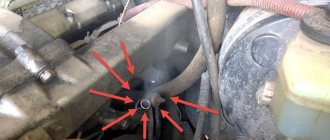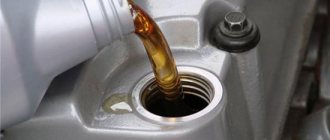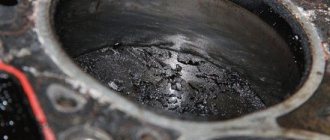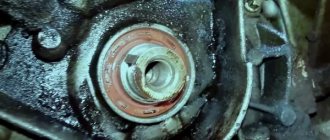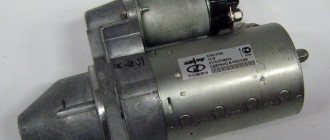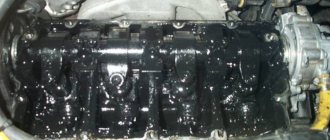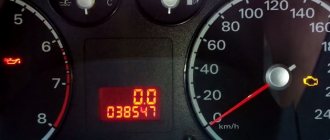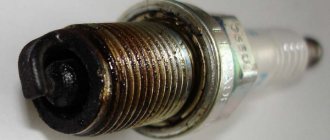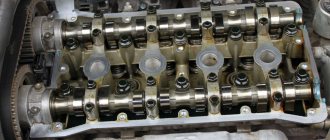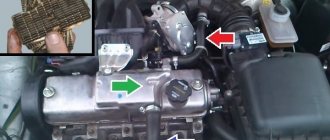Symptoms of a clogged breather - oiling of the outer surface cylinder block in the area of the pipe leading from the crankcase and the oil dipstick, air filter housing or throttle valve. Typically this problem occurs due to untimely service crankcase ventilation systems or in the case when the engine intensively throws out oil through the breather. The latter may be a sign of serious problems, including critical wear of parts of the cylinder-piston and valve groups.
Leakage due to simple clogging of the pipe and oil separator is also dangerous, as it leads to disruption of the engine lubrication system. We will talk about all the main consequences and causes of oil release from the breather and ways to prevent this phenomenon in this article.
Why does oil come out through the breather?
A small amount of oil getting into the breather is not a sign of a problem . One of the functions of this unit is precisely the separation of suspended oil particles contained in crankcase gases and their return to the engine. The main purpose of the breather is to relieve excess pressure in the sub-piston space of the cylinder block by diverting a mixture of water and fuel vapors into the intake manifold.
Breather in the crankcase ventilation system
To make it easier to understand why oil is driven through the breather or dipstick, let’s briefly analyze the design and operating principle of the crankcase ventilation system.
The design may vary slightly depending on the model , but it always includes three main elements - a housing, an oil separator (oil slinger) and one or two pipes. In some cars, the breather is additionally equipped with a valve that opens when a certain pressure in the crankcase or vacuum in the intake is reached.
The flexible hose can connect the crankcase outlet to the intake manifold, engine air filter housing and carburetor (directly through the filter housing or valve cover) or the air hose in front of the throttle body. The oil deflector can be placed in the breather body, in a separate housing, or under the valve cover if the air outlet into the intake is organized from under it.
Additionally, the function of an oil trap is performed by a flame arrester built into the pipe in the form of a spiral wire or mesh.
The general operating principle of all systems is the same: crankcase gases enter the combustion chamber directly through the intake or carburetor, and the oil they contain enters under the valve cover or into the crankcase.
Oil in the intake manifold entered through the breather
Oil trap clogged with sludge
If the ventilation system does not function correctly, the volume of crankcase gases or the content of oil particles in them is too high, the engine throws out oil through the breather in excess, it is not completely separated by the oil deflector and enters the intake manifold and carburetor along with the gases.
Formation of crankcase gases
During the combustion of working mixtures, exhaust gases accumulate under high pressure in the engine cylinders. Due to pressure, some of the gases seep into the crankcase. There they are mixed with oil vapors and condensate moisture. The resulting gas mixture is called crankcase gases.
As pressure increases, the gas mixture breaks through the following elements:
- oil seals;
- breather;
- oil dipstick output;
- seals.
If a characteristic effect called “oil drives” appears, it means that when gases escape, motor oil is involved. To stop moving oil from the breather of a diesel engine, it is necessary to maintain the pressure inside the engine within acceptable limits by removing crankcase gases through the ventilation system.
Symptoms of a malfunctioning crankcase ventilation system
- the smell of burnt oil in the car interior when the engine is running;
- increased fuel and oil consumption;
- traces of oil on the body and breather pipe outside or near them;
- smoke from the oil filler neck when unscrewing the cap;
- clogging of carburetor jets, oiling of the air filter housing, throttle body and the insides of the intake manifold;
- squeezing out oil through gaskets, seals, and dipstick hole.
Some car owners, faced with the problem of oil escaping through the breather, disconnect its pipe from the inlet or filter housing and turn it down. This doesn't fix
the root cause of the problem, but only prevents oil from entering the intake, carburetor and throttle valve.
In addition, toxic crankcase gases
will partially end up in the car interior.
Description of the design of the VAZ 2110 engine ventilation system
The breather with a fixed end of the pipe is located in the lower part of the cylinder block. The opposite end of the pipe connects to the oil separator located in the cylinder head cover. On the opposite side of the head, a special tube is connected to the fitting. This tube is connected to the air inlet pipe.
The operation of the system consists of the following stages:
- The passage of gases into the cavity of the head cover through the diesel breather.
- Separating the oil in the oil separator and supplying it to the valves.
- Mixing and supplying gases to the manifold through the air pipe.
The power unit of this car model is not equipped with a valve that regulates exhaust gas pressure.
In other cars, oil separators may be located in the area of the breather, behind which the pressure valve is located.
Reasons why oil leaks through the breather, gaskets and seals
When the breather is heavily clogged, such high pressure is created in the sub-piston space that oil can be squeezed out of the crankcase even through the inspection hole for the dipstick, oil seals and engine gaskets. Therefore, at the first sign of a malfunction, it is necessary to establish the reasons for the release of oil through the breather. The main problems and their consequences are listed in the table below.
| Cause of oil release | Why is this happening | Consequences |
| Critical wear of the piston rings, less often burnout of the valve or piston | Gases from the combustion chamber break into the sub-piston space. The ventilation system cannot cope with the increased volume. | A drop in compression, a noticeable decrease in engine power, difficulty starting, tripping, oil squeezing out through the seals. |
| Wear of valve stem seals | Excess oil enters the combustion chamber and the piston ring grooves become clogged. Due to the loose fit of the valves to the seats, gases penetrate into the space above the valve, creating excess pressure and disrupting the operation of the crankcase ventilation system. | Increased oil consumption, carbon formation on valve plates and seats, oiling of spark plugs, burnout of valves, accelerated wear of piston rings. |
| Oil deflector clogged | Due to the blockage, the oil particles contained in the crankcase gases are not separated, as a result of which they, along with vapors, enter the intake. | Oiling of the air filter, carburetor jets, throttle valve, deterioration of engine performance due to a violation of the air-fuel mixture. |
| Clogged breather pipe | Oil is released along with crankcase gases as a result of an increase in pressure in the crankcase due to the inability to discharge it through the breather. | Squeezing oil through the dipstick hole, pan gasket, crankshaft oil seal and other seals. It is possible for the pipe to break off from the breather outlet or for gases to penetrate through cracks formed in it. |
| Failed breather valve | Due to the jamming of the valve, pressure does not release when it increases above permissible limits. | Oil squeezing out through seals due to a non-working ventilation system, tripping, deterioration of engine performance due to excess pressure in the sub-piston space. |
| Clogged air filter | Due to the reduced filter capacity, suction occurs along with oil particles from the crankcase ventilation system. | Oiling of carburetor jets, throttle valve (in injection models), violation of the composition of the air-fuel mixture. |
| Oil level exceeded | Excess oil along with gases enters the breather, and the oil separator cannot cope with their removal. | Rapid clogging of the oil separator, formation of oil clots in the hose, and its entry into the intake manifold. |
The road is clear
Now let’s take a closer look at how this happens, how the oil gets from the crankcase to the filter.
- Due to excess pressure, oil particles break out of the crankcase.
- Initially they get inside the oil deflector.
- Next, overcoming the valve, they “move” inside the pipe, which is connected to the purifier body.
- Result: oil traces appear in the filter.
As you can see, everything is quite obvious.
Now let’s look at diagnostics, as well as correction of typical situations using specific examples with cars. That is, let's see how the search for the cause of oil particles getting into the filter should go.
How to treat it
Here’s a common case: a car enthusiast discovered oil in the air filter of a VAZ 2109. You need to figure out what the essence of the problem is. If you do not pay attention to the situation, the consequences can be disastrous, including major engine repairs.
To find out the answer to the car enthusiast’s sacramental question – “why does it throw oil directly into the air filter?” – initially we prepare everything that may be useful to us:
- a pressure gauge, more precisely, a compression gauge, the simplest one equipped with a flexible tube with a thread at the end;
- set of wrenches;
- spark plug key;
- rags, gasoline, brush.
To find out why the engine drives oil into the filter, we proceed as follows.
- We look at the exhaust smoke – we don’t notice a black or blue tint. This means that stuck piston rings can most likely be ruled out.
- We check the oil level with a dipstick - it turns out that there is no excess oil product either.
- We measure the compression of the cylinders. To do this, we unscrew the spark plugs on a warm engine, according to the relevant instructions attached to the compression gauge, take measurements on each of the cylinders, and check the passport data. We find out that the compression corresponds to the standard specified in the car’s registration certificate.
- We notice that there is also oil in the filter pipe, which extends from the breather.
- We dismantle the breather, that is, the crankcase valve. To do this, first remove the valve cover.
- Remove two bolts from the valve cover.
- We take it out, then clean the stack of oil deflector screens with gasoline. We also wash the breather itself with gasoline.
- We perform assembly in reverse order.
This is how you can understand why the VAZ 2109 has oil in the filter, and then fix the problem. Let us add that some car owners simply remove the breather tube from the air intake duct, then lower it down under the engine. However, this serves only as a temporary measure and does not in any way solve the problem itself.
Next we consider another typical case. Suppose there is oil in the air filter of a VAZ 2110 car. We have the following at hand:
- compression gauge;
- spark plug key;
- set of keys, screwdrivers.
As described earlier, we first look at the exhaust and also measure the compression. If the compression is low, we recommend disassembling, diagnosing and repairing the engine. But, let’s say, here, too, the compression turned out to be normal. Then we proceed as follows.
- We find out that there are no deposits at the breather pipe, and that the air-cleaning element has been replaced recently.
- We remember that the engine usually has difficulty starting.
- As an option, we clean the throttle assembly.
- To do this, first remove the decorative engine cover.
- We dismantle the air pipe ventilation hose and find traces of oil inside it. The throttle body's ventilation duct is probably clogged.
- Having loosened the clamps, remove the hoses of the throttle heating channel, as well as the gas tank ventilation system.
- We dismantle the cable and also unscrew the two nuts of the throttle assembly.
- We thoroughly wash the removed throttle assembly with gasoline or a special product with partial disassembly.
We also add that when a VAZ 2112 has oil in the filter, you need to act in the same way.
How much does such a renovation cost today?
Of course, there is always the option of giving the task to servicemen: they say, there is oil in the air filter, look for the reasons! How much will they charge for this? Most likely, they will simply suggest cleaning, for example, the throttle assembly. Well, here are the approximate average prices for eliminating such a malfunction.
| City | Price |
| Moscow | 900 rub. |
| St. Petersburg | 850 rub. |
| Samara | 700 rub. |
| Ekaterinburg | 800 rub. |
| Novosibirsk | 800 rub. |
If you puzzle the technicians solely by searching for an answer to the question of why oil is leaking from the engine into the air filter, then they will probably give the correct answer, and you will have to pay about half as much as for a regular diagnosis of a moderate breakdown.
Now read about replacing the silent blocks of the front arms of the VAZ 2107 and replacing the generator bearing of the VAZ 2110.
Diagnosis and elimination of causes
If a problem occurs when the engine throws oil through the breather, inspect the intake system, crankcase ventilation and perform engine diagnostics. To eliminate the consequences and the cause, start with the air filter and its housing. We replace the clogged filter element and remove oil on the components with a cleaner.
Diagnosis of why oil was squeezed out through the breather: video
- Check the engine oil level by first turning off the engine and waiting at least 15 minutes. The level should not exceed the maximum mark on the dipstick by more than 5 mm. Excess oil must be pumped out through the dipstick hole.
- Inspect the crankcase ventilation system for cracks and blockages in the pipe, oil clots in the oil separator, check the functionality of the PVC valve (if equipped). Contaminants are removed by washing with solvent, gasoline, diesel fuel or kerosene. Failed elements must be replaced.
- We diagnose the condition of the engine. First of all, we unscrew and inspect the spark plugs. The presence of a black glossy coating clearly indicates excess oil in the combustion chamber. We consistently measure the compression in the cylinders.
Normal value
for a diesel engine
24–30 atm
, for an injection car
12–14 atm
, for a carburetor car at least
10 atm
.
The exact value for your model can be calculated by multiplying the engine compression ratio by 1.4
.
The spread between cylinders should not exceed 1 bar. A decrease in compression indicates a leak in the combustion chamber due to burnout of the valve, piston, wear or stuck piston rings. If compression is normal, but there are traces of oil in the chamber, you need to check the valve stem seals.
How to clean the breather?
To clean the breather, you need to disconnect the pipe, remove it from the engine and disassemble the housing, remove the oil separator and valve (if equipped). Wash all parts with gasoline, kerosene or diesel fuel, removing oil deposits. Dry and reassemble in reverse order.
How to disassemble and clean the breather: video
How to clean oil from an air filter: video
Cylinder-piston group
Most often, this option is found on cars with high mileage, where wear on structural elements can be significant. During operation, various components are damaged. They can lose shape and change sizes, which leads to disruption of normal operation. It’s easy to check - you need to measure the compression readings in each cylinder. To do this, use a special device called a compression meter. It can be either mechanical or electronic, there is no fundamental difference.
The measurement process is simple and you can figure it out in a couple of minutes; there are many videos and instructions that describe each action in detail. Everything is quite simple - one person controls the indicators under the hood, and the second at this moment rotates the engine with the starter. It is imperative to take measurements in all cylinders, since it often happens that in three everything is fine, but in one the value does not correspond to the norm.
The generally accepted lower figure is 22 kg/cm2. But the optimal values may vary in different models; the easiest way is to study the operating instructions. If the number is about 30 or slightly higher, the condition of the cylinder-piston group is almost ideal and there is no point in worrying. But when one or more cylinders have values below the minimum, the problem may be one of the following:
- Damage to cartridges. Here you will have to do a major overhaul of the engine, grind and hone the liners, and also select repair rings. In addition, you have to do a number of additional works and replace all components that are worn out or damaged. In some cases, it is necessary to bore the engine and select pistons of larger diameter.
- Problems with pistons. During operation, they may become slightly deformed or damaged. Even a small piece that breaks off from the piston will cause serious problems that will lead to costly repairs. The elements may also burn out.
- Malfunctions can also be caused by other components - valves, bushings, seals, etc. It all depends on the situation and the cause can only be discovered by disassembling the motor. So there is not much difference in what exactly fails - the repair always looks about the same.
Important!
Individual engine models have their own characteristics and characteristic “sores”, so it is advisable to study the available information. For example, the D 245 tractor engine will be very different from the 1.9 TDI version from Volkswagen, both in design and layout. Therefore, it is worth understanding all the nuances.
Frequently asked questions (FAQ)
Why does oil come out through the breather?
The breather provides crankcase ventilation by removing water, fuel and oil vapors formed in it and penetrating from the combustion chamber. A small amount of oil in crankcase gases is acceptable. Oil droplets are collected by the oil separator and returned to the engine. However, the release of excess oil through the breather is a sign of a malfunction in the engine, a clogged crankcase ventilation or air filter.
Why does the engine throw oil into the breather too actively?
Intense squeezing of oil through the breather indicates excess gas pressure in the sub-piston space or improper functioning of the crankcase ventilation. The main causes are worn piston rings or pistons, a clogged pipe or oil separator, and an excessively high oil level.
What happens if you close the breather?
The pressure of the crankcase gases will increase many times, the oil will be squeezed out through the control hole of the dipstick, from under the pan gasket, crankshaft seals and other seals. Therefore, under no circumstances should the breather be turned off.
What to do if there is oil in the intercooler
If grease is detected on the surface or inside the radiator, you need to diagnose the cause of its appearance. What you will need for this:
- check the operation of the pan ventilation;
- replace the filter;
- inspect the seals.
If you have no experience in carrying out such work, you can contact specialists at the service center. If the engine is fully operational, based on the diagnostic results, it is worth adjusting your driving style. Thus, operating the power unit at speeds above 2000 per minute leads to excessive heating of the coolant, especially when driving uphill in mountain serpentine conditions.
After completing these measures, flush the intercooler. To do this you will need:
- remove the intercooler from the power plant, using the recommendations from the vehicle maintenance instructions;
- clean the outside of the radiator from oil and dirt;
- The question of how to flush the intercooler is easily solved; for this purpose, gasoline, kerosene, and acetone are used in equal proportions. This mixture is poured inside the radiator for 12 hours;
- For subsequent cleaning of the intercooler from residual flushing mixture, dishwashing detergent mixed with hot water is suitable;
- Flushing the intercooler is completed with clean heated water.
Prompt detection of oil in the intercooler will allow engine malfunctions to be eliminated in a timely manner, preventing a deterioration in its operating parameters. At all stages of radiator flushing, personal protective equipment should be used and detergents should not come into contact with exposed areas of the body.
Optimal operation of the turbocharger is only possible when the rules for using this high-precision mechanism are followed, otherwise problems will arise. Often the cause of breakdowns is the oil in the turbine. What to do if the turbocharger drives oil?
